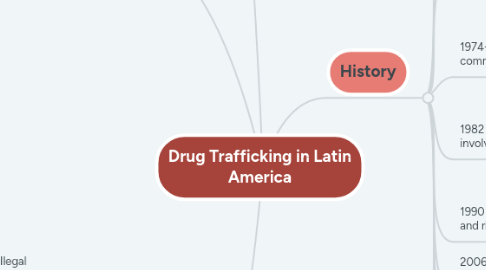
1. Main Actors
1.1. USA - Main receiver and consumer of illegal drugs.
1.1.1. Has started legalization of marijuana.
1.2. Colombia - Main producer and exporter of cocaine.
1.2.1. Is in process of terminating civil war.
1.3. Mexico - Main smugglers and large producers of methamphetamine and cannabis.
1.3.1. Past administrations did heavy armed strategies against the problem.
1.3.2. Current administration has ill-defined methodology to solve problem.
1.4. Peru - Large producers of cocaine.
1.5. Guatemala - Main terrestrial routes cross the country.
1.6. Puerto Rico - Main transshipment point.
2. Main Consequences
2.1. Mass incarceration in the US.
2.2. Corruption between drug lords and governments.
2.3. Political destabilization and violence in Latin America, Asia and Africa.
2.4. Systemic human right's abuses across the world.
3. Current Situation
3.1. Most efforts in the past decades have focused on eradicating the supply of drugs and incarcerating drug traffickers.
3.1.1. Because of this, product developers have focused on creating more powerful drugs that occupy less space.
3.1.2. In turn, the apparent reduction of supply increases prices and recruitment.
3.2. US Drug Enforcement Agency has less than 1% efficiency rate on stopping the flow of drugs into and inside the US.
3.2.1. Statistics indicate murder rate in the US is 25% to 75% higher because of the War on Drugs.
3.2.2. Approximately 400 metric tons of cocaine entered the US.
3.3. Approximately 164,000 people were murdered between 2007 and 2014 because of drug cartel wars in Mexico.
3.3.1. Mexico has become the main smuggler of drugs into the US and Europe.
3.3.2. Drug cartels are able to smuggle drugs into the US and ship some to Europe via Africa.
3.4. According to UNODC the war on drugs costs approximately 435 bn USD/year and drug use has stayed relatively the same.
3.4.1. There must be a call to solve this crisis in different ways to stop it from becoming an even larger threat to peace and security world widely.
4. History
4.1. 1920's - Background: Alcohol Prohibition starts chain of anti-drug policies.
4.1.1. Background: Colombian disputes over coffee territories.
4.1.2. Background: End of the Mexican Revolution.
4.2. 1948 - Colombian Armed Conflict begins with "El Bogotazo"
4.3. 1960's - Armed forces like FARC and ELN form in Latin American countries.
4.3.1. This leads to intervention of CIA in many Latin American countries
4.4. 1971 - Nixon US Administration declares drugs as "public enemy number one".
4.4.1. This starts the "War on Drugs".
4.4.2. At this time, Colombian cartels dominate market and trade via Caribbean seas.
4.4.3. US influence over Latin America pushes governments to start their own anti-drug policies.
4.5. 1974-1982 - Colombian FARC and ELN start communist movements in the country.
4.5.1. AUC forces begin to form as small militias.
4.6. 1982 - CIA and US Military begin involvement in drug interdiction.
4.6.1. By this time the Medellin Cartel, led by Pablo Escobar, links up with the Guadalajara Cartel in Mexico.
4.6.2. This begins traffic from South America to the US through Mexican borders.
4.7. 1990 - Demise of Colombian drug cartels and rise of Mexican illegal drug trade.
4.7.1. During this decade, FARC and ELN gain tremendous power in Colombia.
4.8. 2006 - Felipe Calderon declares war on Mexican drug cartels.
4.9. 2008 - Andean Crisis
4.10. 2011 - Global Commission on Drug Policy Report
4.10.1. "The War on Drugs has failed."
4.10.2. Report recommends to decriminalize unharmful drug users.

